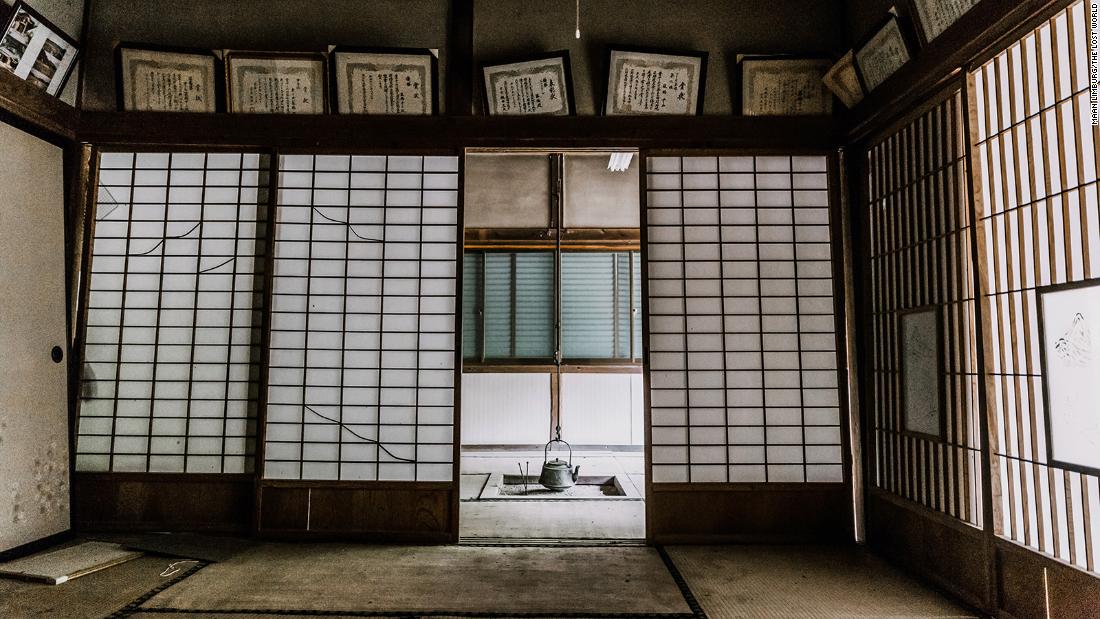
(CNN) — Simply saying the word “Japan” can bring up images of manga, maid cafes and neon lights.
But for Dutch photographer Maan Limburg, Japan is a series of rural landscapes punctuated by empty houses.
Her photographs of these places — from houses departed in the wake of natural disasters to closed-down theaters with the lights still cued up — are now featured in a book, “The Lost World,” which published in May.
Japan’s ghost houses
Enter the phenomenon of akiya, or ghost houses.
A 2014 government report sounded the alarm, saying that, should things continue at the present rate, about 900 villages and towns throughout Japan will be “extinct.”

Limburg didn’t just find empty homes — there were also abandoned businesses like this DVD store.
Maan Limburg/The Lost World
But even free houses aren’t necessarily the cure for Japan’s akiya situation. While other countries with aging populations, like Italy, have given away or sold very cheap houses to foreigners, they often come with a visa or residency permit attached. Japan’s houses, though, do not.
Limburg, who is based in Utrecht, found herself irresistibly pulled to the lesser-known regions of Japan where many of these houses exist. She and her partner spent months there at a time, renting a car or van and driving through parts of the country that many tourists rarely explore.

Finding ephemera like calendars and newspapers can help Limburg figure out when a place was abandoned.
Maan Limburg/The Lost World
Leaving the cities
Limburg says she “fell in love” with rural Japan.
“Every village we got to, the people were like, ‘What are you doing here? The nearest tourist attraction is 35 kilometers. We can send you there. We can draw you a map if you want to.’ It was just really nice to see this different side of Japan,” she says.
And once she began visiting smaller villages, it was practically impossible not to find empty homes or abandoned buildings. At one point, Limburg says, her boyfriend asked if they really had to stop at every single one.
One of the reasons Limburg connected with rural Japan is that it reminded her of her native Netherlands. Though both countries have a reputation for being cold and not always welcoming to foreign visitors, Limburg disagrees.
“As soon as Dutch people see you’re actually interested, they will share a lot of information with you. That’s something I also really found in Japan to be true,” she says. “It’s one of the things I really enjoy in both countries that, if you have real interest in the people, suddenly they really share their life with you,”
But of course not all countryside is the same, and that was reflected in the kinds of empty buildings she found.
In Hokkaido, Limburg explains, many people had time to properly close up and weather-seal their houses before moving away. But in areas like Fukushima, where people had fled in a hurry, it wasn’t unusual to find teacups still set out or TV sets still plugged in.
One of her personal favorite discoveries was a former theater. The sets, costumes and lights were still intact, as if the actors had merely taken a lunch break and were due back any minute.
Some of the smaller homes had the most emotional punch. Limburg saw family photos still tacked up on the wall and found herself wondering what had happened to the people who lived here and what had made them leave.
“I hope to have treated the locations with enough respect,” she says.
Her favorite region was the “magical” northern island of Hokkaido.
“it’s rough and it’s rugged and it’s weird,” the photographer says. “We had a feeling that we were in an Edward Hopper painting without any people.”

“Once you start looking for empty houses,” Limburg says, “they’re everywhere.”
Maan Limburg/The Lost World
Reflections
In all, Limburg has visited Japan about 10 times, beginning when she was a teenager.
Because she is a freelancer, she’s able to spend long periods of time away, so her average Japan visit was three weeks. Multiple trips enabled her to see different parts of the country, as well as to meet and connect with some of the people she encountered along the way.
